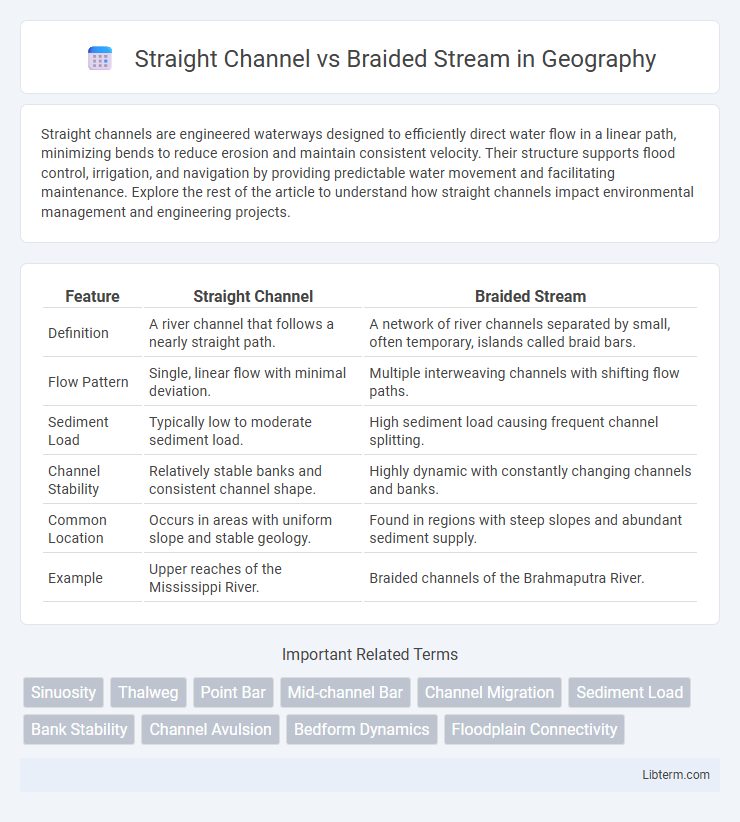Straight channels are engineered waterways designed to efficiently direct water flow in a linear path, minimizing bends to reduce erosion and maintain consistent velocity. Their structure supports flood control, irrigation, and navigation by providing predictable water movement and facilitating maintenance. Explore the rest of the article to understand how straight channels impact environmental management and engineering projects.
Table of Comparison
| Feature | Straight Channel | Braided Stream |
|---|---|---|
| Definition | A river channel that follows a nearly straight path. | A network of river channels separated by small, often temporary, islands called braid bars. |
| Flow Pattern | Single, linear flow with minimal deviation. | Multiple interweaving channels with shifting flow paths. |
| Sediment Load | Typically low to moderate sediment load. | High sediment load causing frequent channel splitting. |
| Channel Stability | Relatively stable banks and consistent channel shape. | Highly dynamic with constantly changing channels and banks. |
| Common Location | Occurs in areas with uniform slope and stable geology. | Found in regions with steep slopes and abundant sediment supply. |
| Example | Upper reaches of the Mississippi River. | Braided channels of the Brahmaputra River. |
Introduction to Stream Channel Types
Straight channels are linear stream segments characterized by uniform flow paths, minimal sediment deposition, and limited habitat diversity. Braided streams consist of multiple interwoven channels separated by transient sediment bars, promoting dynamic flow patterns and varied aquatic habitats. These channel types influence sediment transport, water velocity, and ecological complexity in fluvial systems.
Defining Straight Channels
Straight channels are linear watercourses characterized by uniform, narrow pathways with minimal curvature and relatively stable banks, promoting efficient water flow and sediment transport. These channels often form in regions with consistent slope gradients and cohesive soil types, resulting in reduced lateral erosion compared to braided streams. Unlike braided streams, which display multiple interweaving channels separated by sediment bars, straight channels maintain a single, continuous flow path, influencing habitat diversity and stream morphology.
Understanding Braided Streams
Braided streams consist of multiple interwoven channels separated by temporary sediment bars, typically found in areas with high sediment supply and variable water discharge. Their complex network enhances habitat diversity and influences sediment transport dynamics compared to single, straight channels. Understanding braided streams is crucial for managing flood risks and preserving ecosystems in alluvial plains.
Key Geomorphological Differences
Straight channels exhibit uniform flow paths with minimal curvature, characterized by low sinuosity values typically under 1.5, while braided streams contain multiple interweaving channels separated by transient sediment bars, displaying high sinuosity often above 1.5. The sediment load in braided streams is predominantly coarse-grained, such as gravel and cobbles, promoting frequent channel migration and division, whereas straight channels generally transport finer sediments like sand and silt with stable banks. Hydrologically, straight channels maintain steady flow regimes with limited overbank flooding, contrasting with braided systems that experience variable discharge and significant morphological changes due to dynamic sediment deposition and erosion.
Formation Processes of Each Channel
Straight channels form through consistent water flow in areas with uniform sediment and slope, resulting in a single, stable pathway with minimal erosion. Braided streams develop in regions with high sediment loads and variable flow, where frequent deposition divides the flow into multiple interweaving channels. Variations in water discharge and sediment deposition are key factors driving the dynamic formation of braided patterns compared to the more stable morphology of straight channels.
Sediment Transport and Deposition
Straight channels exhibit uniform flow velocities that promote consistent sediment transport with limited deposition along the channel bed. Braided streams feature multiple interweaving channels causing variable flow regimes, increased sediment load, and significant deposition forming bars and islands. Sediment transport in braided streams is highly dynamic, with frequent erosion and deposition cycles driven by fluctuating discharge and sediment supply.
Ecological Impacts and Habitat Diversity
Braided streams, characterized by multiple interconnected channels and high sediment loads, create diverse habitats such as gravel bars, islands, and shallow pools that support a wide range of aquatic and terrestrial species. In contrast, straight channels tend to have uniform flow and limited habitat heterogeneity, often resulting in lower biodiversity and reduced ecological resilience. The dynamic nature of braided streams enhances nutrient cycling and provides critical spawning grounds for fish, whereas straight channels may contribute to habitat fragmentation and diminished ecosystem services.
Human Influences and Modifications
Human activities such as urban development, agriculture, and river engineering significantly impact the morphology of straight channels and braided streams. Straight channels often result from artificial channelization that confines water flow, reducing habitat diversity and altering sediment transport dynamics. In contrast, braided streams are highly sensitive to changes in sediment supply and water flow caused by deforestation, dam construction, and land use changes, leading to channel simplification or increased instability.
Case Studies: Examples from Around the World
Straight channels, characterized by uniform flow and minimal sediment deposition, have been extensively studied in the Mississippi River, where engineered modifications aimed at flood control altered natural habitats and sediment transport. Braided streams, such as those found in the Brahmaputra River in India and Nepal, showcase dynamic sediment redistribution and multiple intertwined channels, supporting diverse ecosystems but posing challenges for flood management. Comparative case studies from these global examples highlight how channel morphology influences riverine biodiversity, sediment dynamics, and human infrastructure resilience.
Choosing the Right Channel for Engineering and Restoration
Selecting the appropriate channel type is crucial for engineering and restoration projects, as straight channels provide efficient, predictable flow ideal for hydraulic control, while braided streams offer complex, dynamic patterns supporting diverse habitats and sediment transport. Engineers favor straight channels where precise water conveyance and flood control are priorities, whereas restoration efforts often utilize braided streams to enhance ecological resilience and natural geomorphological processes. Evaluating site-specific hydrology, sediment load, and ecological goals ensures the optimal balance between structural stability and environmental sustainability.
Straight Channel Infographic

 libterm.com
libterm.com